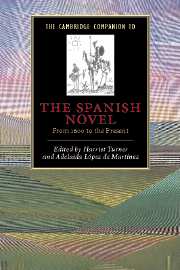Book contents
- Frontmatter
- 1 On the novel: mirror and text
- Part 1 Since Cervantes
- Part 2 The nineteenth century
- 4 The regional novel: evolution and consolation
- 5 The folletín: Spain looks to Europe
- 6 The realist novel
- 7 History and fiction
- 8 Gender and beyond: nineteenth-century Spanish women writers
- 9 Decadence and innovation in fin de siglo Spain
- Part 3 The twentieth century
- Bibliography
- Index
- Series List
8 - Gender and beyond: nineteenth-century Spanish women writers
from Part 2 - The nineteenth century
Published online by Cambridge University Press: 28 May 2006
- Frontmatter
- 1 On the novel: mirror and text
- Part 1 Since Cervantes
- Part 2 The nineteenth century
- 4 The regional novel: evolution and consolation
- 5 The folletín: Spain looks to Europe
- 6 The realist novel
- 7 History and fiction
- 8 Gender and beyond: nineteenth-century Spanish women writers
- 9 Decadence and innovation in fin de siglo Spain
- Part 3 The twentieth century
- Bibliography
- Index
- Series List
Summary
Accounts of the evolution of narrative forms in Spanish literature often hinge on an unacknowledged notion of progress in which expressions of pride accompany resentment at the world's failure to recognize national achievements. A glorious start (Cervantes, the picaresque novel) was followed by a period of decline (the unpatriotic eighteenth century, the underdeveloped local-color piece, the contemptible serialized novel), then a reawakening (to use Menéndez Pelayo's term) during the nineteenth century with the emergence of the great masters of realism, notably Pérez Galdós. As Alda Blanco has argued, this trajectory is often narrated as a sexualized competition, in which “feminine” forms, linked with mass culture, are despised or ignored, while more “virile” forms are held up to compete with the work of celebrities such as Balzac or Zola. In describing this narrative trajectory as a response to anxiety over legitimacy, both sexual and national, feminists today are engaged in a healthy critique of literary standards and the evaluative rhetoric of evolution that implies literary perfectibility.
The process of reassessing a feminine tradition begins with a search, discovery,reediting and reevaluation of what has been excluded from the predominantlymale canon. In the case of Spain this process is still in its initialphase, although considerable impetus has come recently from the collectionof women writers edited by Castalia in conjunction with the Instituto de laMujer (‘Institute for Women’s Affairs’).
- Type
- Chapter
- Information
- The Cambridge Companion to the Spanish NovelFrom 1600 to the Present, pp. 122 - 137Publisher: Cambridge University PressPrint publication year: 2003
- 4
- Cited by



